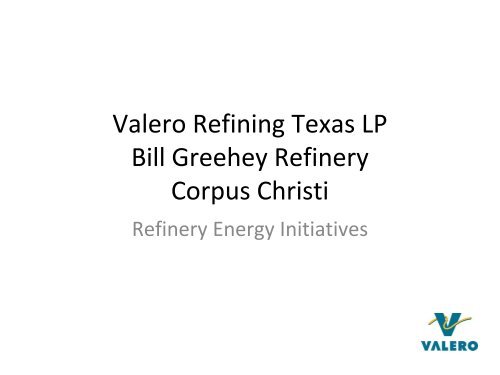Valero Energy Corporation Bill Greehey Refinery Corpus Christi
Valero Energy Corporation Bill Greehey Refinery Corpus Christi
Valero Energy Corporation Bill Greehey Refinery Corpus Christi
Create successful ePaper yourself
Turn your PDF publications into a flip-book with our unique Google optimized e-Paper software.
<strong>Valero</strong> Refining Texas LP<br />
<strong>Bill</strong> <strong>Greehey</strong> <strong>Refinery</strong><br />
<strong>Corpus</strong> <strong>Christi</strong><br />
<strong>Refinery</strong> <strong>Energy</strong> Initiatives
<strong>Valero</strong> Overview<br />
• <strong>Valero</strong> <strong>Energy</strong> <strong>Corporation</strong> is a Fortune 500 company<br />
based in San Antonio, and is North America’s largest<br />
independent petroleum refiner and marketer. <strong>Valero</strong><br />
supplies fuel and products that improve people’s lives<br />
with 15 refineries and 10 ethanol plants stretching<br />
from California to Canada to the Caribbean.<br />
• <strong>Valero</strong>’s efforts in alternative energy range from<br />
production of corn ethanol to wind energy to<br />
investments in emerging bio‐fuels development.<br />
• <strong>Valero</strong>’s company‐owned retail Corner Stores offer<br />
customers fast, friendly service in a safe and clean<br />
environment
<strong>Bill</strong> <strong>Greehey</strong> <strong>Refinery</strong><br />
Overview<br />
• <strong>Valero</strong> commissioned the grass‐roots <strong>Corpus</strong> <strong>Christi</strong> refinery in 1983, now<br />
referred to as the <strong>Bill</strong> <strong>Greehey</strong> <strong>Refinery</strong> West Plant<br />
• In 2001 <strong>Valero</strong> acquired a 115,000 BPD refinery, now referred to as<br />
the <strong>Bill</strong> <strong>Greehey</strong> <strong>Refinery</strong> East Plant<br />
• East and West plant facilities have a total feedstock throughput capacity<br />
of about 315,000 BPD<br />
• <strong>Refinery</strong> has three independent steam systems and two fuel gas systems<br />
– East and West fuel gas systems receive gas from a third party supplier in<br />
addition to internally produced gasses<br />
• Hydrogen is purchased from two outside suppliers as well as produced<br />
internally<br />
– East, West and <strong>Valero</strong> Three Rivers <strong>Refinery</strong> hydrogen systems connect via<br />
third party supplier networks as well as <strong>Valero</strong> owned East/West tie line<br />
• The refinery purchases power as well as produces power from internally<br />
produced waste energy
Historic <strong>Energy</strong> Activities<br />
• Steam Trap Program<br />
– Surveys completed every one to two years<br />
– Costs associated with improperly functioning traps are quantified and repairs scheduled<br />
– Historic failure rate has been 3.5%<br />
• Corporate <strong>Energy</strong> Scorecard<br />
– Program has been in place since 2006<br />
– Individual items reported include such things as Solomon EII, heater and boiler excess air and stack<br />
temperatures, Crude Unit heater approach temperatures, steam balancing and venting, hot rundown<br />
giveaway, slop reprocessing, amine strengths and loadings and ammonia content of stripped sour waters<br />
– Individual items are weighted and an overall score assigned<br />
• Weekly Fired Heater Report<br />
– Program in place since 2007<br />
– Excess air and stack temperature targets have been established for all major fired furnaces and boilers<br />
– Reports submitted weekly with actual values and deviations from targets<br />
– Costs of deviations from target are calculated based on current fuel values<br />
– Results as well as actions required to correct deviations are reviewed with Corporate Operations<br />
Management weekly<br />
• Leak Detection and Repair Programs<br />
– Emphasize operating practice of reporting leaks for prompt repair<br />
– Follow up with consultant surveys
Historic <strong>Energy</strong> Activities<br />
• Monthly <strong>Energy</strong> Business Unit Review<br />
– Monthly teleconference held with all refineries, corporate energy personnel and corporate operations<br />
management<br />
– <strong>Energy</strong> Scorecards, Weekly Heater Reports and results of <strong>Energy</strong> Stewardship Program are reviewed<br />
– Provides a forum for lessons learned to be communicated across the corporation<br />
• Solomon <strong>Energy</strong> Intensity Index, EII<br />
– Calculated monthly and reported to corporate with other Solomon indicators<br />
• Capital Project Design Reviews<br />
– All capital projects subject to design review that includes optimizing energy consumption according to<br />
corporate return on capital requirements<br />
• <strong>Energy</strong> Coordinator<br />
– A senior member of the engineering staff also functions as the <strong>Refinery</strong> <strong>Energy</strong> Coordinator<br />
– Responsibilities include maintenance of <strong>Energy</strong> Scorecard, Weekly Heater Reports and Solomon EII<br />
calculation<br />
• Utility Balances<br />
– Spreadsheet based tools retrieving information from the refinery historian are available for technical and<br />
operations management use in monitoring and balancing systems<br />
– Real time balance information also displayed for operations staff use<br />
– Steam, fuel gas, power and hydrogen systems are included
Corporate <strong>Energy</strong> Stewardship Program<br />
Overview<br />
• Initiated in 2007<br />
• Involves all refineries in corporation<br />
• Introduced to <strong>Bill</strong> <strong>Greehey</strong> <strong>Refinery</strong> in 2009
Corporate <strong>Energy</strong> Stewardship<br />
Program Basics<br />
• Program begins with an energy gap review<br />
conducted by plant personnel, corporate<br />
personnel and an energy consultant<br />
• All units and utility systems are reviewed<br />
• Items from gap reviews are approved and<br />
entered into the <strong>Energy</strong> Log<br />
• The <strong>Energy</strong> Log is spreadsheet based and<br />
contains information on the item, anticipated<br />
benefits, responsible parties and schedule for<br />
review and/or implementation<br />
• Priority is given to non‐capital items
Corporate <strong>Energy</strong> Stewardship Program<br />
<strong>Energy</strong> Models<br />
• Consultant used to build energy input models<br />
for all units.<br />
• Past best performance is determined and<br />
used as the basis for current static targets.<br />
• This information is presented graphically and<br />
in tabular format and is reviewed by<br />
management, operations and engineering<br />
daily
Corporate <strong>Energy</strong> Stewardship Program<br />
<strong>Energy</strong> Team<br />
• <strong>Refinery</strong> <strong>Energy</strong> Team was formed<br />
• Members of the team include Operations Director,<br />
Complex Managers, Engineering Director, <strong>Energy</strong><br />
Coordinator, Technical Services Manager and others as<br />
needed<br />
• Makeup of team differed from other <strong>Valero</strong> Refineries<br />
in that team was made up of individuals with authority<br />
to implement actions quickly<br />
• Weekly team meetings are held where <strong>Energy</strong> Log,<br />
Weekly Heater Report and other energy related items<br />
are reported and reviewed
Corporate <strong>Energy</strong> Stewardship Program<br />
Dynamic <strong>Energy</strong> Targets<br />
• Next phase of program involves setting<br />
dynamic energy targets for individual units<br />
and refinery as a whole<br />
• Consultant utilized to regress plant data to<br />
determine energy consumption correlations<br />
according to unit conditions, severities, etc<br />
• This phase of program currently being<br />
prepared for rollout
Corporate <strong>Energy</strong> Stewardship Program<br />
<strong>Energy</strong> Dashboards<br />
• <strong>Energy</strong> Dashboards are being constructed to<br />
display real time information on monitors in all<br />
control rooms, individual desk tops and the<br />
corporate office<br />
• Dashboards have drill down capabilities to<br />
determine what items are not achieving targets<br />
on a unit and energy source basis<br />
• Deviations from target are coded to show<br />
magnitude of deviation<br />
• Exception reports are issued
Corporate <strong>Energy</strong> Stewardship Program<br />
Results to Date<br />
• Current captured savings are approximately<br />
twice the initial estimates and have provided<br />
a return on investment four times the<br />
minimum required by the corporation<br />
• Further savings are anticipated as the<br />
program progresses
Questions?



